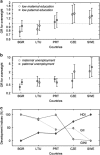Socioeconomic inequalities in childhood overweight: heterogeneity across five countries in the WHO European Childhood Obesity Surveillance Initiative (COSI-2008)
- PMID: 27136760
- PMCID: PMC4856730
- DOI: 10.1038/ijo.2016.12
Socioeconomic inequalities in childhood overweight: heterogeneity across five countries in the WHO European Childhood Obesity Surveillance Initiative (COSI-2008)
Abstract
Background: Excess risk of childhood overweight and obesity occurring in socioeconomically disadvantaged families has been demonstrated in numerous studies from high-income regions, including Europe. It is well known that socioeconomic characteristics such as parental education, income and occupation are etiologically relevant to childhood obesity. However, in the pan-European setting, there is reason to believe that inequalities in childhood weight status may vary among countries as a function of differing degrees of socioeconomic development and equity.
Subjects and methods: In this cross-sectional study, we have examined socioeconomic differences in childhood obesity in different parts of the European region using nationally representative data from Bulgaria, the Czech Republic, Lithuania, Portugal and Sweden that were collected in 2008 during the first round of the World Health Organization (WHO) European Childhood Obesity Surveillance Initiative.
Results: Heterogeneity in the association between parental socioeconomic indicators and childhood overweight or obesity was clearly observed across the five countries studied. Positive as well as negative associations were observed between parental socioeconomic indicators and childhood overweight, with statistically significant interactions between country and parental indicators.
Conclusions: These findings have public health implications for the WHO European Region and underscore the necessity to continue documenting socioeconomic inequalities in obesity in all countries through international surveillance efforts in countries with diverse geographic, social and economic environments. This is a prerequisite for universal as well as targeted preventive actions.
Figures

References
-
- Stunkard A, d'Aquili E, Fox S, Filion RDL. Influence of social class on obesity and thinness in children. JAMA 1972; 22: 579–584. - PubMed
-
- Shrewsbury V, Wardle J. Socioeconomic status and adiposity in childhood: a systematic review of cross-sectional studies 1990–2005. Obesity 2008; 16: 275–284. - PubMed
-
- Bambra CL, Hiller FC, Cairns JM, Kasim A, Moore HJ, Summerbell CD. How effective are interventions at reducing socioeconomic inequalities in obesity among children and adults? Two systematic reviews. Part 1: how effective are public health interventions at reducing socioeconomic inequalities in obesity among children? Public Health Res 2015; 3: 5–38.
-
- Wijnhoven TMA, van Raaij JMA, Spinelli A, Rito AI, Hovengen R, Kunesova M et al. WHO European Childhood Obesity Surveillance Initiative 2008: weight, height and body mass index in 6–9-year-old children. Pediatr Obes 2013; 8: 79–97. - PubMed
-
- World Health OrganizationGlobal status report on noncommunicable diseases 2014. World Health Organization: Geneva, Switzerland, 2014. Available from: http://www.who.int/global-coordination-mechanism/publications/global-sta... (accessed August 2015).
MeSH terms
Grants and funding
LinkOut - more resources
Full Text Sources
Other Literature Sources
Medical

